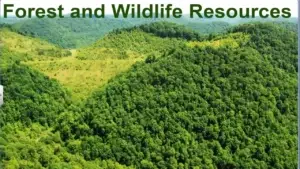
Exercise Question Answers:
Multiple Choice Question:
Q1. Which one of these statements is not a valid reason for the depletion of flora and fauna?
(a) Agricultural expantion
(b) Large scale developmental projects
(c) Grazing and fuel wood collection
(d) Rapid industrialization and urbanisation
Answer: (c) Grazing and fuel wood collection
Q2. Which of the following conservation strategies do not directly involve community participation?
(a) Joint forest management
(b) Beej Bachao andolan
(c) Chipko Movement
(d) Demacration of Wildlife sanctuaries
Answer: (d) Demacration of Wildlife sanctuaries
Q3.Match the following:
Reserved forests | other forests and wasteland belonging to both government and private individuals and communities |
Protected forests | forests are regarded as most valuable as far as the conservation of forest and wildlife resources |
Unclassed forests | forests land are protected from any further depletion |
Answer:
Reserved forests | forests are regarded as most valuable as far as the conservation of forest and wildlife resources |
Protected forests | forests land are protected from any further depletion |
Unclassed forests | other forests and wasteland belonging to both government and private individuals and communities |
Q4. Answer the following questions in about 30 words.
(i) What is biodiversity? Why is biodiversity important for human lives?
(ii) How have human activities affected the depletion of flora and fauna? Explain.
Answer:
(i) Biodiversity is the degree of variation of life forms within a given ecosystem, or on an entire planet. There are millions of living organisms on planet earth. All these living organisms, including man, are interdependent on each other.
(ii) Cutting down of forests for agricultural expansion, large scale developmental projects, grazing and fuel wood collection and for urbanization has led to the depletion of flora and fauna.
Q5. Answer the following questions in about 120 words.
i) Describe how communities have conserved and the protected forests and wildlife in India?
ii) Write a note on good practices towards punjabi forest and wildlife.
Answer:-
(i). A). In the Chipko movement, the protest has successfully resisted deforestation. The community has affordated with indigenous species to be successful.
B). The Beej Bachao Andolan in Tehri District of the Uttrakhand promoted traditional agriculture and knowledge systems.
C). Villagers have raised their voice against Mining activities in the Sariska wildlife sanctuary in Rajasthan.
ii) A). To conserve forest and wildlife is common among the tribal communities.
B). In villages, people worship Tulsi plants and banana leaves.
C). Such beliefs help to preserve the plant and animal species.
D). Narmada Bachao Andolan and Chipko movement show the involvement of local communities in conserving forest and wildlife.
E). All conservation measures as well as programmes, should be eco- friendly whatever development steps are undertaken by the government.
EXTRA QUESTIONS
Q1. Which are the causes of decline in Indian biodiversity?
Answer:-
1. Habitate destruction
2. Hunting
3. Poaching
4. Environmental pollution
5. Forest fires.
Q2. What are causes behind the depletion of forest resources?
Answer:
- Large-scale development projects have been the cause of loss of forest.
- Mining is another important factor behind the forestation.
- Grazing and fuel wood collection are the greatest degrading factor behind the depletion of forest resources.
- Project like the Narmada Sagar Project in Madhya Pradesh.
Q3. How are the forest classified?
Answer:- There are 3 categories of forest:-
1. Reserve Forest:- Reserve forest are regarded as the most valuable so far as the conservation of forest and wildlife resources are concerned.
2. Protected forest:- Almost 1/3 of the total forest area is protected forest as declared by the Forest Department. This forest land are protected from any further depletion.
3. Unclassed forests:- Other forest and waste land belongings to both government and private individuals and communities.
Q4. Explain the measures taken app by the government for conservation of fauna in India.
Answer:-
1. The Indian wildlife act was implemented in 1972 to protect habitats.
2. An all India list of protected species was published.
3. Banning, hunting and giving legal protection to their habitats.
4. Central and state governments have established National Park and wildlife sanctuaries.
5. The central government also announced several projects for protecting specific animals.
Q5. Explain the features of joint forest management program.
Answer:-
1. The programmes involve local communities in the management and restoration of degraded forest.
2. State of Odessa passed the first resolution for joint forest management.
3. Local villagers, undertake protection activities.
4. in return, the members of these communities are entitled to the intermediary benefits.
For more Question: Click below
Question Answer – Resources and Development
******************************************************************
Pingback: Question Answers-Minerals and Energy Resources-Class 10-SST